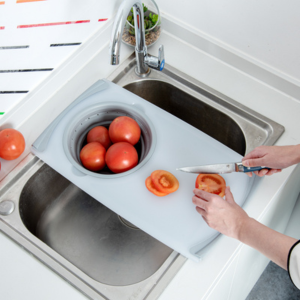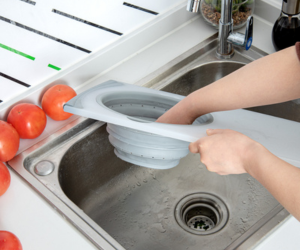Kitchens can quickly become overcrowded, especially for those who live in compact city spaces. However, you can significantly improve your kitchen's functionality and workspace with the right tools. One such innovative tool is the over-the-sink cutting board.
This practical kitchen accessory extends your countertop over your sink, utilizing space that would usually go unused. It offers additional room for food preparation and makes cleaning up a breeze. Let's delve into how to use an over-the-sink cutting board effectively.
Using The Over-The-Sink Cutting Board
When it comes to kitchen tools, an over-the-sink cutting board often proves to be a game-changer. By turning what is often unused space above the sink into a functional area, you can enhance your cooking experience while keeping your kitchen neat and tidy. Now that we understand its benefits, let's move into the essentials, how to use it:
- Installation: Place the cutting board securely over the sink to create additional workspace in your kitchen. Ensure that the cutting board fits snugly over the sink for stability.
- Food Rinse And Strain: Utilize the built-in collapsible strainer to easily rinse and strain fruits, vegetables, or other ingredients. Expand the strainer when needed and collapse it for convenient storage.
- Food Preparation: Use the board as you would any other cutting board. Chop, slice, or dice your fruits, vegetables, or meats on the board. The extra space over the sink makes it easier to manage food.
- Food Transfer: The board's strategic location next to the stove allows you to quickly transfer food from the board to your fry pan or stock pot without the need for extra bowls.
- Cleanup: Once you are done, cleaning up is easy. Wash the cutting board with mild soap and water after each use. The plastic material allows for quick and effortless cleaning.
- Storage: After cleaning, make sure the board is thoroughly dried to prevent damage or mold. Then, simply store the board in a cutting board rack or hang it using the designated hanging hole. The collapsible strainer feature makes storage more compact.
Benefits Of An Over-The-Sink Cutting Board
Before getting into the 'how,' it's crucial to understand 'why' such an accessory can make a significant difference in your kitchen operations. Firstly, an over-the-sink cutting board is the ultimate space-saving solution, especially for those with limited kitchen areas.
By effectively utilizing the often overlooked space above the sink, it dramatically expands your workspace, providing a comfortable and dedicated area for cutting, chopping, and preparing ingredients. This innovative design allows you to make the most out of your kitchen, transforming it into a more functional and organized cooking environment.
- Space Maximization: The over-the-sink cutting board serves as an ultimate space-saver for those with limited kitchen space. Using the untouched area over the sink drastically expands your workspace for comfortable cutting or kneading.
- Easy Cleanup: This tool significantly simplifies the cleanup process. With in-built chutes leading directly to the sink, it allows you to slide waste straight into the basin, reducing clean-up time.
- Swift Food Transition: The cutting board's strategic location enables instant transfer of food items from the board to the pan or pot. This quick action helps preserve food freshness and flavors.
- Multitasking: Over-the-sink cutting boards can perform an array of tasks, from rinsing and straining within the board to sorted food storage in built-in compartments. It reduces the use of multiple kitchen utensils.
- Enhanced Organization: Dedicating a specific area for cutting tasks aids in maintaining an organized kitchen and effectively limits the spread of mess.
Maintenance And Safety Tips For Your Over-the-Sink Cutting Board
It's essential to care for and maintain your over-the-sink cutting board properly to extend its life and ensure its safety and usability. Moreover, following simple safety tips can make all the difference in keeping your kitchen accident-free. Here are some basic pointers for cutting board maintenance and safety practices, which will help your board serve you better and longer.
- Regular Cleaning: Clean your cutting board thoroughly with dish soap and warm water after each use. This not only helps maintain hygiene but also prevents food residues from damaging the board's surface.
- Drying: After cleaning and disinfecting, allow the board to air dry, ensuring all moisture evaporates. Proper drying prevents potential mold growth, warping, or cracking over time.
- Surface Check: Inspect your cutting board's surface regularly for deep grooves or cuts that may harbor bacteria. If your plastic board has rough areas or significant gouges, consider replacing it.
- Using Separate Boards: To minimize the risk of cross-contamination, consider using separate cutting boards for different food categories, such as raw meat, fruits, and vegetables.
- Avoid Overloading: While your over-the-sink cutting board may provide extra workspace, don't overload it with heavy pots or pans. This can lead to instability or cause the board to break.
- Stability Checks: Before using the cutting board, ensure it is properly secured and stable above the sink. A wobbly board can be dangerous and increase the risk of accidents.
- Knife Safety: Always use sharp knives when cutting, as dull ones require more force and may slip, increasing the risk of injury. Handle knives with care and use proper cutting techniques.

Tips For Efficient Food Prep Using An Over-The-Sink Cutting Board
Ever wonder how to make your kitchen tasks easier? Enter the over-the-sink cutting board. It's not just for chopping; think of it as your kitchen helper, saving space and making cooking simpler. Now, let's explore some easy tips for using it like a pro.
- Batch Preparation: Plan your meal prep by organizing ingredients that require similar cutting or washing. For example, wash all your produce and then move on to meats.
- Utilize The Collapsible Strainer: Take advantage of the built-in collapsible strainer. Rinse vegetables or fruits in the strainer while chopping others on the board. This simultaneous approach saves time and water.
- Prep In Stages: Divide your food preparation into stages. Start with washing and chopping, then move to seasoning and marinating. This helps in maintaining a smooth workflow.
- Sort Ingredients: Use different sections of the cutting board for different ingredients. Keep sliced vegetables on one side, diced fruits on another, and so on. This organization prevents cross-contamination and makes it easier to transfer ingredients to cooking pots or pans.
- Waste Disposal: Directly slide waste into the sink using the over-the-sink design. This minimizes mess and eliminates the need for a separate waste bowl, streamlining the cleanup process.
- Strategic Positioning: Position the cutting board strategically to minimize movement. Place it closer to the stove for quick transfers of prepped ingredients to cooking pots or pans.
- Multi-Tasking: While waiting for one ingredient to cook, continue with the preparation of others. This multitasking approach ensures that your overall cooking process is efficient.
- Use The Sink For Additional Tasks: Besides using the sink for waste disposal, consider using it for additional tasks. Fill pots with water for boiling, clean utensils, or keep frequently used tools within arm's reach for a seamless cooking experience.
- Prep Components For Multiple Meals: If possible, prep components that can be used across multiple meals. For example, chop extra vegetables to use in salads or stir-fries throughout the week.
- Knife Selection: Choose the right knives for different tasks. A sharp chef's knife is excellent for slicing and dicing, while a smaller paring knife might be suitable for detailed work.
- Clean As You Go: Wipe down the cutting board between different ingredients to prevent flavor transfer. This practice also keeps your workspace tidy and ensures a clean surface for each task.
- Adapt To Recipe Requirements: Consider the specific requirements of the recipe you're preparing. If a recipe calls for prepped ingredients to be set aside, plan your cutting board space accordingly.

Maximizing Kitchen Efficiency
An over-the-sink cutting board is an excellent tool for small kitchens, offering additional workspace and promoting easy clean-up. It's a transformative solution for maximizing space, streamlining tasks, and enhancing your overall cooking experience. From providing additional workspace to simplifying cleanup and enabling efficient food prep, this innovative accessory proves to be a game-changer in small kitchens and beyond.
As you embark on your culinary journey, consider the versatility and functionality that the over-the-sink cutting board brings to your kitchen. With proper care, safety measures, and the implementation of efficient food prep tips, this kitchen companion can truly elevate your cooking game. So, make the most of this ingenious tool, and let it become an indispensable part of your kitchen routine, turning each meal preparation into a seamless and enjoyable process.








